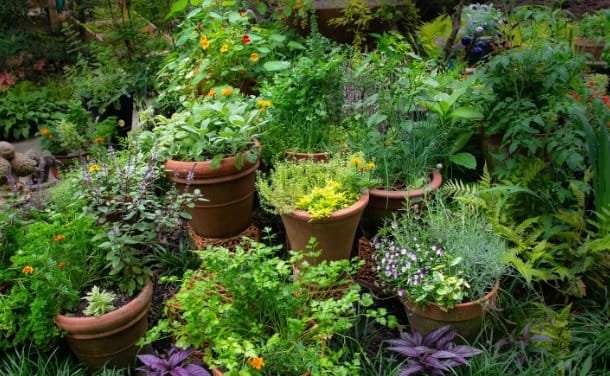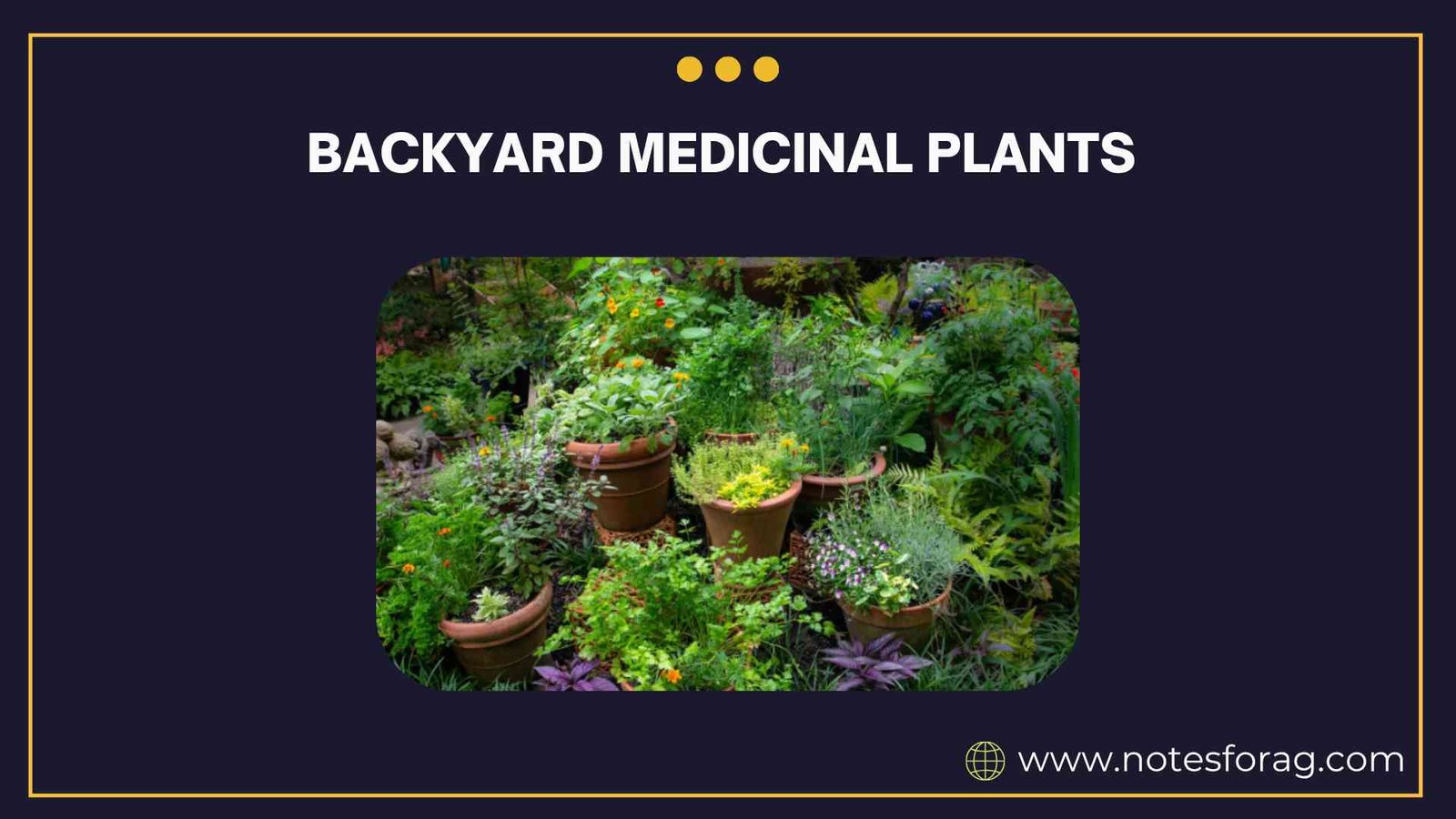1. Introduction

Backyard medicinal plants are a wonderful way to bring natural healing power right to your doorstep. These plants have been used for centuries in traditional medicine for treating various ailments naturally and safely. Growing medicinal plants in your garden is not only beneficial for your health but also adds beauty, fragrance, and biodiversity to your outdoor space. They require minimal care, adapt well to home gardens, and can provide fresh herbs anytime you need them.
Summary of Backyard medicinal plants
- Backyard medicinal plants offer natural, affordable remedies for common health issues and reduce reliance on synthetic medicines.
- Growing these plants is easy and adaptable to any garden size, providing fresh, chemical-free herbs at your doorstep.
- Besides health benefits, tending to medicinal plants promotes well-being by connecting you with nature and encouraging sustainable living.
Table of Contents
2. Importance of Backyard Medicinal Plants
Medicinal plants play a vital role in holistic health care systems around the world. Having a collection of these plants in your garden means you have immediate access to natural remedies without relying on pharmaceutical products. This helps reduce healthcare costs and minimizes chemical use. Beyond personal health, these plants improve the garden ecosystem by attracting pollinators such as bees and butterflies, and supporting beneficial insects that help keep pests in check.
3. Selecting the Right Medicinal Plants for Your Backyard
Choosing suitable medicinal plants depends on your local climate, soil conditions, available space, and the types of health benefits you want. For instance, if you want to boost immunity and treat respiratory problems, Tulsi is ideal. For skin care, Aloe Vera is an excellent choice. It’s best to start with plants that are easy to grow and maintain, then gradually expand your collection based on your garden’s environment and personal needs.
4. Common Backyard Medicinal Plants and Their Uses
1. Tulsi (Holy Basil)

Tulsi is considered a sacred herb in many cultures and is known for its powerful medicinal properties. It helps fight infections, reduce stress, and improve immunity. Tulsi grows well in pots or garden beds and needs regular watering and sunlight.
2. Aloe Vera
Aloe Vera’s thick, succulent leaves contain a soothing gel that is excellent for treating burns, cuts, and dry skin. It is drought-tolerant and prefers sunny spots with well-drained soil.
3. Mint
Mint is widely used to aid digestion, relieve headaches, and freshen breath. It grows vigorously and spreads quickly, making it perfect for containers to avoid overtaking your garden.
4. Neem
Known as the “village pharmacy,” neem has antifungal, antibacterial, and insect-repelling properties. It requires more space as it grows into a large tree but is invaluable for skin problems and natural pest control.
5. Ginger
Ginger root is commonly used to reduce nausea, inflammation, and improve digestion. It prefers a warm, shady environment and moist soil, making it ideal for growing under taller plants.
6. Lemon Grass

Lemon Grass has a refreshing citrus aroma and is used to calm nerves, reduce anxiety, and relieve headaches. It grows well in sunny, well-drained soils and can be harvested regularly.
5. How to Cultivate Backyard Medicinal Plants
1. Soil Preparation
Most medicinal plants thrive in fertile, well-drained soil rich in organic matter. Before planting, mix compost or aged manure into your garden soil to improve its texture and nutrient content.
2. Watering Practices
Medicinal plants usually require moderate watering. While Aloe Vera prefers drier conditions, plants like Ginger need consistent moisture. It’s important to water plants according to their specific needs to avoid root rot or drought stress.
3. Sunlight Needs
Different plants have varying light requirements. For example, Aloe Vera and Lemon Grass flourish in full sun, while Ginger prefers partial shade. Understanding these needs helps your plants grow healthy and strong.
4. Pest and Disease Management
Avoid using chemical pesticides on medicinal plants. Instead, use organic methods such as neem oil sprays, introducing natural predators, or companion planting with pest-repellent species to keep your garden safe and chemical-free.
6. Harvesting and Storing Backyard Medicinal Plants
Timing is key for harvesting medicinal plants to ensure the highest concentration of active compounds. Leaves are best harvested early in the morning when dew has dried, while roots and barks are usually collected during the plant’s dormant season. After harvesting, dry the plant parts in a shaded, airy place to preserve their potency. Store dried herbs in airtight containers away from direct sunlight.
7. Uses and Preparation of Backyard Medicinal Plants
Medicinal plants can be used fresh or dried in several ways. You can make herbal teas, apply fresh leaves or gels directly to the skin, prepare tinctures, or extract essential oils. For example, Tulsi tea helps soothe colds, Aloe Vera gel can calm burns, and fresh mint leaves relieve stomach discomfort.
8. Benefits of Growing Medicinal Plants at Home
Homegrown medicinal plants provide fresh, chemical-free remedies that are more effective and safe than store-bought products. They save money on healthcare, reduce environmental impact by avoiding packaged medicines, and help you connect with nature. Gardening these plants is also therapeutic and can relieve stress, improve mood, and encourage a healthier lifestyle.
9. Common Challenges and Solutions
Some common challenges when growing medicinal plants include pest attacks, diseases, improper watering, or lack of knowledge. You can overcome these by educating yourself through gardening groups, books, or online tutorials. Using organic pest controls, practicing crop rotation, and choosing disease-resistant varieties also help maintain a healthy garden.
10. Conclusion
Growing medicinal plants in your backyard garden is a practical and rewarding way to incorporate natural health care into your daily life. These plants have been trusted for centuries for their healing properties and continue to offer safe, effective remedies for common ailments such as colds, digestive issues, skin problems, and stress relief. By cultivating medicinal plants at home, you not only gain immediate access to fresh, chemical-free herbs but also reduce dependence on store-bought medicines, which often come with higher costs and synthetic additives.
Successful cultivation of medicinal plants requires understanding their individual needs, such as soil type, watering frequency, sunlight exposure, and pest management. Many of these plants are hardy and adaptable, making them suitable for a variety of climates and garden sizes. Whether you have a spacious garden or just a few pots on a balcony, you can grow beneficial plants like Tulsi, Aloe Vera, Mint, Ginger, and Neem with relative ease.
Moreover, tending to a medicinal garden offers therapeutic benefits beyond physical health. Gardening itself reduces stress, encourages mindfulness, and connects you more deeply with nature’s cycles. As you learn to harvest and prepare these plants making teas, gels, or tinctures you also become more knowledgeable and self-reliant in managing your well-being naturally.
Challenges such as pests or diseases can arise but can often be managed organically through natural pest repellents and companion planting. With the right care and attention, your medicinal garden can thrive, offering both beauty and function.
In conclusion, backyard medicinal plants are a valuable addition to any home. They provide affordable health solutions, support sustainable living, and foster a closer relationship with nature. Embracing medicinal gardening empowers you to nurture both your garden and your health, making it a fulfilling and holistic practice for today’s lifestyle.
Frequently Asked Questions (FAQs)
Are there any medicinal plants that can be grown indoors?
Yes, several medicinal plants thrive indoors, such as aloe vera, chamomile, mint, and basil. Place them near a sunny window or under grow lights to ensure they receive sufficient light. Regularly check for pests and maintain proper humidity levels to keep them healthy.
How do I harvest and store medicinal herbs?
Harvest herbs during their peak growth stage, typically in the morning after the dew has dried. Use clean, sharp scissors to cut the desired parts. Dry the herbs by hanging them upside down in a cool, dry place or using a dehydrator. Once dried, store them in airtight containers away from direct sunlight to preserve their potency.
Can medicinal plants be used alongside conventional medicine?
While many medicinal plants have health benefits, they should not replace professional medical advice or treatment. Always consult with a healthcare provider before using herbal remedies, especially if you are pregnant, nursing, or taking prescription medications. Some herbs can interact with medications, so it’s essential to ensure safety.
Related Articles

